Mohit Tater's Blog, page 12
September 3, 2025
How Strategic M&A Structures Like Triangular Mergers Support Business Growth

A triangular merger is one of the types of M&A structures in which one company indirectly acquires another company. That said, the acquiring company creates a subsidiary company to complete the transaction with the target company. Triangular mergers are further categorized into two categories: a forward triangular merger and a reverse triangular merger.
What are these two types, and how are they beneficial for businesses? Let’s find out.
Merger vs. acquisition: how are they differentBefore moving to triangular mergers, it is important to know that mergers and acquisitions are two different business transactions. An acquisition gives the acquiring company full or significant control over the other business. Mergers mean two different entities combining operations to merge and usually create a new business entity.
What is a forward triangular merger?A forward triangular merger is a form of subsidiary merger in which a buyer purchases a target by means of a “subsidiary” or shell company. In a forward triangular merger, the target business “vanishes” into the shell business following the merger.
Advantages and limitations of forward triangular mergersTriangular mergers are beneficial in multiple ways, but they have pitfalls of their own as well.
Perks of forward triangular mergersTax benefits. There are tax implications of mergers and acquisitions of this type. The underlying reason for the majority of forward triangular mergers is tax benefits. By purchasing the target firm with a mix of stock and cash, as opposed to solely cash, the acquiring company can deduct tax on the voting stock it issues to purchase the target firm and save substantially on taxation.Lessened liabilities. Forward triangular mergers differ from direct mergers as they require the target company to become a subsidiary. This ensures that the acquirer is safe from the target’s liabilities, including pending legal liabilities. The parent company faces much lower risk compared to other merger and acquisition plans.Easier to undertake. The ease of sale benefits the target company. Once the transaction is concluded, the target company remains a subsidiary. This makes it easier to sell than a fully merged entity in the future (if needed).Pitfalls of forward triangular mergersDiscontinuity. The discontinuity resulting from the target company’s “vanishing” into the shell company once the deal is sealed could raise problems. Upon transition, existing contracts and licenses which were previously entered into by the target company will be legally null and void, such that the new company will have to re-enter into them. This contrasts significantly with a reverse triangular merger, wherein one of the significant benefits is continuity.Additional expenses. A forward triangular merger usually entails additional expenses, since the acquiring entity will need to organize and manage a subsidiary. This is usually a complicated process, which is costly. This is not exclusive to forward triangular mergers, since reverse triangular mergers tend to have this form of added expense as well.
Liabilities. Though liabilities can be a strength of forward triangular mergers, they can also be a weakness since there may be existing legal or financial liabilities within the target firm. The acquirer should undertake a strong due diligence process to reveal as many liabilities as possible prior to completing the transaction.What is a reverse triangular merger?
Similar to a forward triangle merger, a reverse triangular merger is also a subsidiary merger where the acquiring firm forms a shell company with the sole purpose of acquiring a target company.
However, it is different because the target company absorbs the shell company. This type of transaction underlies most SPAC deals.
In simple words, in a reverse triangular merger, the shell company “vanishes” in the target company once the merger has been made.
Advantages and disadvantages of reverse triangular mergersPerks of reverse triangular mergersDecreased liability. Decreased liabilities are also a part of reverse triangular mergers. The acquirer gains full control of the target firm’s assets without assuming its liabilities since the target retains its legal identity, which signifies that contracts, leases, and licenses are not required to be transferred.Continuity. In contrast to forward triangular mergers, the target firm continues to exist as a distinctive entity after the reverse triangular merger is completed. That means none of the contractual agreements previously entered into by the target firm are forfeited in the deal.
Tax benefits. There are significant tax advantages. If properly handled, and over 80% of the acquirer’s stock is utilized to finance the merger, the reorganization can be a tax-free reorganization, imposing no tax liability on the acquiring firm.Drawbacks of reverse triangular mergersIntegration problems. Since the target company continues to exist as its entity, natural differences exist between the target and acquiring companies. With a reverse triangular merger, fully combining the two firms can be fraught with integration issues, such as employee resistance and cultural clashes. With a forward triangular merger, the target firm is merged into, and integration tends to be less complicated.
Unhappy target company shareholders. Target shareholder discontent in a reverse triangular merger is prevalent. The target firm can remain a distinct entity on paper, but its previous shareholders generally have diminished control. This occasionally precipitates litigation for shareholders who consider that the merger did not work in their favor.
Legal complications and costs. The legal intricacies and costs involved in this type of merger’s specificity can be substantial. To be compliant with laws in places, businesses ought to possess the proper internal or external legal advisors and the needed resource allowance if they are going to undertake a reverse triangular merger.Summing it up
Triangular mergers help excel business growth as they allow the acquiring company to buy another entity without taking on the liabilities directly. A subsidiary in this process streamlines legal and tax complexities, which preserves contracts and minimizes disruptions. This structure supports faster expansion and integration in competitive markets.
The post How Strategic M&A Structures Like Triangular Mergers Support Business Growth appeared first on Entrepreneurship Life.
How Virtual Data Rooms Streamline Cross-Border M&A Deals

In the modern business world, the process of merger and acquisition (M&A) within international boundaries has emerged as a strategic platform whereby a firm focuses on growing, attaining international markets, or leveraging the market as a competitive advantage. Such deals, though, hold a lot of potential; they are also accompanied by some complex problems, particularly with the sensitive information management across borders, cultures, and regulatory systems.
There is a single headline tool that has become a game-changer in defeating those obstacles: the virtual data room (VDR). Beyond being a digital file storage, current VDRs have added advanced data room functionalities and deal collaboration technology, making all aspects of the M&A process simpler, secure, and faster.
Why Cross-Border M&A Is Complex by NatureThe cross-border M&A deals involve various stakeholders, including legal teams, accountants, financial advisors, regulatory agencies or nations, and corporate leadership. Such deals involve:
Differences across time zones, which can become a drag in communication and decision-making.Regulatory diversity, since each jurisdiction has different regulations governing data privacy, anti-trust best practices, and taxation.Language barriers that may cause misunderstanding in the main documents.High stakes for confidentiality, as the unauthorized disclosure may spoil the value of a deal or halt it.Such a complex process can be overwhelming unless the right technology is present. That is where virtual data rooms come in very useful.
What Is a Virtual Data Room?A virtual data room is a protected cloud platform that is used to store, distribute, and control sensitive business content. VDRs are designed for high-value transactions and are unlike consumer-grade cloud storage.
They usually provide:
Bank-grade encryption to protect data in transit and at rest.Granular permission controls allow users to see only information that applies to their role.Audit logs record the who, what, and when of viewing or downloading each file.Integrated Q&A sections with which to elucidate on details internally.These characteristics present VDRs as great opportunities in the cross-border M&A, where transparency is contrasted by the confidentiality demands.
The Role of Virtual Data Rooms in Cross-Border M&AIn the case of international cooperation, time zones, and regulatory systems, the M&A process can be a chaotic experience without secure and structured software. The complexity is reduced through the use of virtual data rooms, as all parties involved in the task (buyers, sellers, and advisors) can operate within the same secure environment.
1. Secure, Centralized Document StorageIn any M&A deal, due diligence should compile vast amounts of sensitive information — financial records, contracts, intellectual property documents, compliance reports, and more. With virtual data room software, all stakeholders can access a single centralized repository.
2. Streamlined Communication with Deal Collaboration ToolsThe present-day VDRs support deal collaboration features, allowing one to message in real-time, tag, and be notified. In cross-border transactions, party members could be miles and even time zones apart, and this capability ensures that everyone is on the same page without necessarily having to meet or continuously send and receive emails.
3. Regulatory Compliance Made EasierSharing international documents with other countries must be guaranteed by data protection laws like the EU’s GDPR, the U.S. CCPA, or Australia’s Privacy Act. To assist with meeting these legal requirements, VDRs may contain compliance settings that display data localization, auto-watermarking, etc.
4. Faster Due DiligenceVDRs also assist teams with finding information they need, as the documents are logically organized. These search features are provided in real time. This hastens the vetting process, which would be helpful most of the time, especially during bidding, where time is critical.
Choosing the Right VDR ProviderChoosing an adequate virtual data room is as important as employing one. Vendors differ in pricing, ease of use of the interface, security certification, and customer care services. Elisa Cline, a marketing specialist, claims: “The best VDR isn’t just a storage tool — it’s a deal accelerator that fits your workflow and compliance needs.”
This is why it is crucial to consider the best virtual data room providers and select the necessary software for the cross-border M&A deal. A mature provider in international transactions could take sympathetic action to what you may not see coming, such as multi-language support, country-specific data protection laws, and so on.
Key Features to Look for in Cross-Border M&A VDRsVirtual data room solutions are not identical, and the needs of cross-border transactions cannot be defined as merely storing documents. The appropriate site must present robust security, usability, and cooperation functions adjusted to the challenges of operating within countries and legal frameworks.
Multi-language interface and translation tool enable translation between teams in different countries.Advanced permission settings enable detailed control over who sees, edits, or downloads the document.Mobile compatibility ensures that executives at international locations can securely access documents everywhere.Powerful Q&A and commenting tools are used to eliminate the time lag in resolving queries relating to the deal.Dedicated customer support includes 24/7 help on the phone or via chat to handle all potential difficulties.A Typical Cross-Border M&A Workflow Using a VDRAlthough each cross-border M&A transaction is unique, there is a standard set of stages involved. A well-organized virtual data room facilitates all these stages to smooth information flow and comply with all international requirements.
Preparation phase. The seller loads important corporate files into the VDR and structures the files into folders based on due diligence checklists. Different groups of users are granted access (e.g., buyer legal counsel, accountants).Due diligence phase. Buyers log in to access documents, ask questions, and get more paperwork. All of the activity can be tracked on the platform with audit trails.Negotiation phase. The updated version of the agreements can be shared by both parties in the VDR without confusion about the versions.Final agreements. Final contracts are saved within the VDR in a long-term format for accessibility when agreements are drawn.This efficient system eliminates the complex deal process associated with physical data rooms, cutting down expenses and improving transparency amongst all parties.
The Strategic Advantage in Cross-Border DealsVDRs don’t just make document handling more efficient — they also create a competitive edge. In international M&A, the ability to demonstrate organized, well-protected information can increase buyer confidence, shorten deal timelines, and even improve valuation.
For sellers, this means presenting their company in the best possible light. For buyers, it means making informed decisions based on accurate, accessible data.
ConclusionRegardless of their nature, cross-border M&A transactions are extremely complicated; however, technology can convert them into opportunities. Virtual data room platforms, particularly those with advanced deal collaboration facilities, have revolutionized the process through which international transactions are made.
The VDR has become a strategic need, rather than a nice-to-have. Whenever a company or an investor enters the international M&A market, the platform that helps them close the deal remains the deciding factor.
The post How Virtual Data Rooms Streamline Cross-Border M&A Deals appeared first on Entrepreneurship Life.
The Secret to Getting Construction Permits Approved in Half the Time

Anyone who’s ever worked in construction or development knows that one of the biggest hurdles to getting a project off the ground isn’t always the budget, design, or even the labor—it’s the permit. In fact, permitting delays have become one of the most frustrating bottlenecks for contractors, developers, architects, and even national retail brands.
You submit your plans, wait weeks for a response, only to be told that you’re missing a form, or worse, that your entire submission needs revisions. Then you refile, wait again, and repeat the process—sometimes for months. Meanwhile, project costs creep up, opening dates get pushed, and teams sit idle.
But what if there were a way to dramatically reduce that cycle—not by cutting corners or gaming the system, but by rethinking how the entire permitting process is managed?
Let’s unpack the real reasons permits take so long and the new methods that are helping builders cut approval times in half.
Why Permits Take So Long (and It’s Not Just the City)Before we dive into solutions, it’s important to understand the root of the issue. The common assumption is that city governments are slow or inefficient—and while that’s sometimes true, the bigger issue is usually on the applicant’s side.
Here are a few recurring problems:Incomplete applications: A shockingly high number of submissions lack essential information, documents, or signatures. Cities often reject these outright, starting the clock over again.Jurisdiction confusion: In multi-jurisdiction areas, it’s not always clear who approves what. Missing even one local agency’s requirement can derail the entire timeline.Miscommunication: A project manager might think the architect submitted something, while the architect assumes it’s being handled by the contractor. Without centralized tracking, things fall through the cracks.No follow-up process: After submission, many teams go into “wait mode,” assuming they’ll be notified if anything is needed. In reality, cities are often waiting on a response from the applicant.The Secret: Treat Permitting Like a Core Phase of the ProjectToo many teams treat permitting as a passive task—something that happens between design and construction. The truth is, permitting is its own phase, requiring dedicated tools, workflows, and accountability.
Here’s how the smartest firms are getting approvals faster than anyone else:1. Start with Deep Permit ResearchEvery city and county has its own permitting quirks. Before a single drawing is made, the best teams do a full permit landscape scan: which permits are needed, what the submission timelines are, and who the reviewers will be.
This step alone prevents months of delays due to missed documents or incorrect assumptions.
2. Centralize All Permit-Related Documents and TasksRather than leaving permit-related responsibilities scattered across email chains, spreadsheets, and Dropbox folders, fast-moving teams bring everything into one dashboard.
Who owns each task? What’s been submitted? What’s pending review? When’s the expected response date? The more visibility, the fewer surprises.
3. Proactively Manage Communication with CitiesPermits don’t move on their own. High-performing teams don’t wait for the city to call—they actively follow up, clarify requirements, and check status updates. They also document every exchange, so if a reviewer changes midway, nothing gets lost in translation.
4. Loop in Local Experts When NeededEven national developers are realizing that a plan reviewer in Austin will ask different questions than one in Phoenix. Bringing in local architects or permit expediters familiar with that specific city’s review process can often mean the difference between a 30-day and 90-day approval.
It’s not just about the drawings—it’s about knowing how that city interprets and enforces code.
5. Leverage Smart Technology Designed for PermittingThere’s been a recent shift toward platforms built specifically for the permitting phase—tools that automate common tasks, flag incomplete applications, and track real-time updates across jurisdictions.
This is where Pulley permitting comes into play. By combining intelligent software with on-the-ground permitting expertise, this approach is helping teams submit cleaner applications, manage reviewer feedback more efficiently, and keep their timelines tight. While it’s not the only option on the market, it’s one of the most complete systems designed for real-world permit complexity.
Real Impact: What Faster Permitting Actually MeansCutting your permitting time in half isn’t just about moving faster—it’s about unlocking real business value.
Retail chains get stores open in time for the holiday rush rather than missing key sales periods.Multi-family developers shave months off construction timelines, reducing carrying costs and accelerating leasing.Contractors avoid costly rework caused by rushed or rejected submissions.Architects gain time back for design rather than chasing paperwork.And for everyone, faster approvals reduce frustration and improve the relationship with the jurisdiction—because cities prefer working with applicants who are organized, responsive, and respectful of their processes.
Final ThoughtsThere’s no silver bullet in construction permitting, but there is a smarter way. It’s about shifting from reactive to proactive, from scattered tools to centralized platforms, and from siloed roles to collaborative teams.
Whether you’re building your 100th store or breaking ground on a single residential project, treating permitting as a strategic phase—worthy of its own workflows, tools, and experts—is the real secret to moving faster.
The result? Fewer delays, clearer expectations, and most importantly, construction that starts on time.
The post The Secret to Getting Construction Permits Approved in Half the Time appeared first on Entrepreneurship Life.
How to Build Employee Programs That Actually Drive Engagement

Most organizations know they should be doing more to engage their employees. After all, engaged employees are more productive, loyal, creative, and committed. But here’s the hard truth: simply launching an employee program isn’t enough.
Too often, companies introduce initiatives—wellness perks, mentorship efforts, volunteer days—that look great on paper but fall flat in practice. Why? Because they were built around assumptions instead of real needs. Because they were designed as top-down mandates instead of collaborative experiences. Because they were made to check boxes, not to build culture.
If your employee programs aren’t moving the needle, it’s time to take a step back and rethink how they’re built. True engagement doesn’t come from flashy perks. It comes from a sense of belonging, purpose, and growth—and the best employee programs support all three.
Here’s how to create programs that actually resonate with your people—and create lasting engagement as a result.
1. Start by Listening, Not AssumingIt’s easy to think you know what your employees want. But even the most well-intentioned assumptions can lead to programs that miss the mark.
Instead, start by asking. Use surveys, small focus groups, or one-on-one conversations to understand what matters most to your employees right now. Are they feeling disconnected? Overwhelmed? Underappreciated? Motivated but unsure of where to grow?
These conversations should be the foundation of any program you build. If you want engagement, start with empathy.
2. Tie Programs to Purpose, Not Just PerksA snack bar or a yoga class might feel like a treat—but those things won’t move the engagement needle unless they’re connected to a larger purpose.
Ask yourself:
What is this program trying to solve or improve?How does it reinforce our values and culture?How will employees feel as a result of participating?Whether it’s a mentorship initiative, a DEI learning series, or a recognition program, the goal should be to help employees feel more connected to the company—and to each other.
3. Involve Employees in the Creation ProcessIf you want your people to care about a program, involve them in its creation. This doesn’t mean handing them the entire strategy, but it does mean including their voices in the decision-making process.
Form a committee made up of employees from different departments and levels. Ask them to test ideas, provide honest feedback, and help shape the rollout plan. When people feel ownership, they’re more likely to participate—and to encourage others to do the same.
It also sends a powerful message: “Your voice matters here.”
4. Make Inclusion a Core Design PrincipleAn employee program that only appeals to a select few will never create widespread engagement. One of the most important principles of successful program design is inclusion.
That means considering:
Different schedules and time zonesPhysical and mental abilityLanguage and communication preferencesCultural and religious differencesRemote vs. in-office dynamicsThe more flexible and inclusive your program is, the more likely it is to resonate across the board. Engagement thrives when people feel seen and considered.
5. Communicate the Why—and Keep CommunicatingOne common reason employee programs fail? Poor communication. People don’t know what the program is, why it exists, or how to get involved.
Before you launch anything, get crystal clear on your messaging. Explain the “why” behind the program in a way that connects with real employee needs. Share stories. Highlight expected benefits. Use multiple channels—email, chat platforms, team meetings, intranet—so your message sticks.
And don’t just promote the program at launch. Keep the momentum going with updates, success stories, and reminders. Engagement isn’t a one-time ask—it’s a continuous conversation.
6. Align with Leadership—but Don’t Let It Be Top-DownLeadership support is crucial for employee programs to thrive. But there’s a big difference between support and control.
Great programs are often led by employees and championed by leaders—not dictated by them. When leaders participate in a genuine, non-performative way (attending events, recognizing participation, sharing their own experiences), it creates authenticity and signals that the program matters.
If employees see leadership buying in, they’re more likely to buy in too. But if it feels like another directive from the top, participation will wane.
7. Build in Feedback Loops and FlexibilityEven the best-designed programs will need adjustments. That’s why it’s critical to build in feedback mechanisms from the start.
Ask participants what’s working and what’s not. Create space for anonymous suggestions. Pay attention to participation data and behavior. And most importantly, be willing to change course if something isn’t resonating.
Knowing how to run employee programs? It starts with being responsive. Engagement is a moving target, and the programs that succeed are the ones willing to evolve with the needs of their people.
8. Celebrate Wins—Big and SmallRecognition fuels motivation. When employees see that their participation is appreciated and celebrated, they’re more likely to stay engaged.
This doesn’t always mean handing out rewards or bonuses (though those can help). It can be as simple as highlighting program milestones in company meetings, sharing success stories in your newsletter, or posting shout-outs on internal channels.
Celebrating progress reminds people that their involvement matters—and helps build momentum for the future.
9. Connect Programs to Career GrowthEngagement isn’t just about feeling good—it’s also about feeling like you’re going somewhere. The most effective employee programs help individuals grow, both personally and professionally.
Whether it’s a leadership development series, a mentorship track, or cross-functional collaboration opportunities, tying programs to long-term career paths adds real value. It shows your people that you’re invested in more than their output—you’re invested in their future.
Final ThoughtsEngaging employees isn’t about throwing more perks at the wall and seeing what sticks. It’s about designing experiences that help people feel connected, valued, and inspired to contribute.
When you build employee programs with intention—rooted in empathy, aligned with purpose, and responsive to feedback—they stop being “extra” initiatives. They become essential parts of your culture.
Because at the end of the day, engagement isn’t a program. It’s a relationship. And like all relationships, it needs care, attention, and a little creativity to truly thrive.
The post How to Build Employee Programs That Actually Drive Engagement appeared first on Entrepreneurship Life.
Why Domain Names Matter in the Digital Landscape

In today’s digital-first world, a domain name is far more than a technical address. It’s the front door to a brand’s identity. It shapes first impressions, reinforces credibility, and serves as a foundational element in building trust with a digital audience. A well-chosen domain becomes synonymous with the business itself, and anchors its presence across platforms.
Memorability and clarity play critical roles in user behavior. Consumers are more likely to engage with websites that feature intuitive, brand-aligned domains, ideally with a .com extension, which remains the most recognized and trusted globally.
A concise, easy-to-type URL reduces the chances of user error and improves shareability, particularly in word-of-mouth recommendations or offline marketing. From brand recall and SEO performance to how professionally a business is perceived, the domain name is a subtle but powerful indicator of legitimacy. Essentially, it’s a digital asset that no serious brand can afford to overlook.
How to Choose an Effective Domain NameA domain name should be simple and memorable, as well as distinctive. Selecting the right name is a strategic decision that blends creativity with foresight. It is strongly connected with brand identity. New and emerging brands in particular need to create something that is both catchy and trustworthy, and use a domain that will last long into the future.
A strong domain should be short, memorable, and aligned with the brand’s voice. Names that are easy to pronounce and spell tend to stick with audiences, and help to improve direct traffic and reduce the chances of typos. Symbols, numbers, and overly complex words often create confusion and can diminish a brand’s professional image and should generally be omitted. Ideally, a domain should capture the essence of the brand while leaving space for future growth.
Selecting and securing a domain name is not a complicated process, especially with a platform like GoDaddy that offers valuable promotions and money-saving coupons to purchase protected domain names. Integrating such offers into the purchasing decision isn’t just about saving money—it’s about making smart, long-term investments.
For entrepreneurs working with limited budgets, even modest discounts can free up resources for other critical brand-building activities. Exploring verified offers for GoDaddy on Discoup before completing a purchase ensures that cost does not become a barrier to securing a high-quality domain. In this context, a discounted domain is not a compromise—it’s an efficient step toward establishing a strong, professional online foundation.
Buying Your Domain: Registrars, Security, and Long-Term TipsOnce you and your team have decided on or shortlisted domain name ideas, the next step is to check availability. It’s possible that your preferred domain name already exists. Godaddy has a handy domain checker tool that lets you search availability. If your choice is not available, it may provide the option to acquire if it is possible, and also suggests alternative available names.
When choosing between new or pre-owned domains, you may have the choice to try and purchase the existing one. This comes with a fee, and in many cases is a worthy investment given the importance of the decision. Your domain name should be as as possible, and needs to have longevity long into the future.
Verifying domain ownership or history can be done with GoDaddy and by using a WHOIS lookup tool for basic information such as registration and expiration dates. To verify ownership for more specific purposes, like SSL certificates, you’ll need to add a specific DNS record provided by the service you’re verifying with. Once this is complete, confirm the change with GoDaddy.
Renewal terms and policies should not be overlooked. Failing to renew a domain on time can result in loss of ownership, with expired domains sometimes snapped up by opportunistic buyers. Enabling auto-renewal or setting calendar reminders helps ensure uninterrupted ownership. And another tip – some businesses also register common misspellings, alternate TLDs, or regional variations of their domain to prevent competitors or bad actors from capitalizing on similar names—a simple but effective brand protection strategy.
In an ever-crowded digital space, acquiring the right domain is both a strategic and symbolic step toward long-term brand success. More than a URL, it serves as a central pillar of recognition and trust. It is important to take the time to choose and register a domain thoughtfully, because it sets the stage for a stronger, more resilient online presence.
The post appeared first on Entrepreneurship Life.
Coupon Marketing: How Entrepreneurs Can Leverage Discounts

In the competitive world of entrepreneurship, getting your product in front of the right audience can be a steep challenge. One clever and effective strategy to attract these eyeballs? Coupon marketing. Whether you’re running a startup or managing a small business, using platforms like Coupora can give you the edge you need.
Why Use Coupon Marketing?Ever consider how shoppers camp online just for Black Friday discounts? People like a good deal, period. Whether it’s a Scottish yokel or an Upper East Side dame—it’s innate; we’re all wired to appreciate a good steal.
Increase in Sales: It’s simple – offer folks a discount, and they’re more likely to buy. Picture this: a would-be customer aimlessly checks out your online store, a 20% off coupon pops up. Boom. That online cart fills up quicker than a pizza place offering free slices. Shoppers like the illusion of beating the system. A discount? It’s practically a win-win.Customer Retention: Here’s another slice of the pie – customer loyalty. Coupons aren’t just for reeling them in for the first time. They’re a chum for the school of customers coming back for more. A ‘thank you’ 10% off for a second purchase could very well convert ‘one and done’ folks into ‘hell yeah, let’s ride this again’ people.Competitive Edge: The market is spilling with choices. Here’s where the coupons slide in, an X-factor making your brand the apple of the customer’s eye. A juicy discount could swing Mr. Hem-and-Haw from your competitor’s side to becoming an ardent patron of your store.According to Tom Church, Co-Founder of Coupora.com, the discount code platform, “Coupon marketing isn’t just an ode to consumerism; it’s a major tool, sharpened and ready to be deployed. Whether it’s about bolstering sales, retaining old chums, or outsmarting competitors, discount codes can do a world of good.” It’s a modern-day beacon for entrepreneurs, the North Star guiding us to the promised land of customer satisfaction and sales.
Types of Coupons to ConsiderWhen crafting your marketing strategy, selecting the right type of coupon can significantly impact consumer behavior. Here are a few popular options:
Percentage DiscountsWhat it is: Offer customers a set percentage off their total purchase.Benefits:Simple and enticing.Encourages higher spending to maximize savings.Example: Trying to move $100 items quickly? Apply a 20% discount and watch them fly off the shelves.Buy One, Get One (BOGO)What it is: An offer that encourages customers to buy in bulk.Benefits:Excellent for clearing out old or slow-moving inventory.Perceived as high value because customers receive something for free.Free ShippingWhat it is: An often overlooked but powerful incentive for online shoppers.Benefits:Removes the barrier of shipping costs.Can significantly increase ecommerce conversion rates.Loyalty DiscountsWhat it is: Exclusive, tailored deals for repeat customers.Benefits:Focuses on retaining existing customers rather than only acquiring new ones.Creates a sense of exclusivity and belonging, encouraging repeat purchases.Choosing the right type of coupon can enhance customer satisfaction and drive sales, balancing your need to move inventory while fostering customer loyalty.
How to Implement a Successful Coupon StrategyThe magic of coupon marketing lies in crafting a thoughtful, well-targeted strategy. To ensure success, there are four key factors to consider:
Firstly, know your audience. The best coupon in the world is useless if it doesn’t resonate with your customer base. Are your clients eager for discounts? Are they more swayed by free shipping? Or are they looking for exclusive members-only steals? Understanding the psyche of your target audience is vital. The golden rule? Deliver the value they perceive, not what you think they want.
Second on the list: smart distribution. Use diverse channels to distribute your coupons. Email newsletters are a great way to reach loyal customers while social media can help tap into a broader, possibly younger demographic. Look into having partnerships with complementary businesses to maximize exposure. Diversification is key, buddy.
Then, we have clear expiry dates. Coupons are often impulse triggers. They create a sense of urgency that can push undecided customers over the purchasing line. A clearly visible ‘use by’ date ignites the ‘now or never’ philosophy and prompts quicker buying decisions.
Lastly but crucially, track performance. The scatter-gun approach? Not cool. Instead, use analytics to monitor performance. With time, you’ll see which type of coupons generates the best response and highest sales. Leveraging such data will help you refine your coupon strategy and focus on what works.
Remember, coupon marketing isn’t monetarily free. It’s crucial you ensure its effectiveness in driving higher returns. A well-planned strategy that considers these elements can have customers flocking to your products, increase sales and immensely boost customer retention.
In the dynamic arena of business, one must embrace strategies that both boost revenue and foster customer engagement. However, as with all things, it’s crucial to steer clear of pitfalls that could potentially sabotage your efforts. When it comes to coupon marketing, consider these potential traps:
One of the most common is over-discounting. Yes, discounts are enticing, and yes, offering tantalizing deals may seem like the stepping-stone to customer acquisition. But here’s the rub: overuse of discounts may lead customers to question your product’s quality. If your product is constantly on sale, they might wonder if it’s worth purchasing at full price. Worse yet, incessant discounting can eat into your profit margin, leaving you with unsatisfactory returns despite increased sales. The trick lies in striking a balance. Dive into discounts, but don’t drown in them.
Next on the list is offering coupons with complex terms and conditions. Nothing sends a potential customer running quite like convoluted fine print. Shoppers love simplicity. They crave deals that are easy to understand and a snap to avail. If your customers spend more time decoding your offer than making a purchase, they might just decide to click away. Therefore, strive for clarity; make sure your terms and conditions are as straightforward as possible.
Lastly, there’s a silent killer in business that one may often overlook: ignoring feedback. Listen – your customers have a voice. They have an opinion on your offering, your website, your service. If they take the time to share their thoughts, it’s wise to listen and take action. More often than not, their words can lead to valuable changes that strengthen the connection between your brand and your customers.
So there you have it. Coupon marketing is indeed an effective tool, but it’s important you use it wisely. Understanding and avoiding these pitfalls is a solid step towards fostering a successful discount strategy for your business.
Real-Life Success Stories with Coupon MarketingCoupon marketing has revolutionized the way a few legendary brands have managed to carve out their space in the market. Here are a couple of instances that might inspire you:
1. PepsiCo: For several decades, PepsiCo had been a distant second to Coca-Cola in the soda market. In the early 1970s, PepsiCo played their card right by doubling down on coupon campaigns. They launched the “Pepsi Challenge”, a blind taste test that cheekily argued that people preferred Pepsi over Coke. Aggressively circulating coupons as part of this campaign, they successfully increased their market share by a notable 14%, closing the gap with their rival. PepsiCo’s success underscores the importance of innovation in crafting a coupon campaign that is memorable and effective.
2. Bed Bath & Beyond (BB&B): This home goods retailer is well-known for their distinctive blue and white 20% off coupons. By dispatching these coupons extensively across direct mail, email, and e-commerce platforms, BB&B successfully lured a massive volume of customers to both their online and brick-and-mortar stores. Even though they’ve cut back on paper coupons recently to focus on digital coupons and loyalty programs, they’ve convincingly illustrated the power of a well-implemented coupon campaign to increase footfall and drive sales growth.
3. Groupon: This global e-commerce marketplace itself is a colossal testament to successful mass coupon marketing. Groupon connects subscribers with local merchants by offering activities, travel, goods, and services in 15 countries. By mastering the art of coupon distribution, Groupon helped businesses reach out to a much larger audience, while customers benefited from steep discounts.
The takeaway here? Believe in the coupon game. It’s not just about offering a cheaper price; it’s about creating a customer relationship that has them coming back. Whether you’re a small start-up or a growing business, inspiring loyalty, and increasing visibility, all while maintaining your profit margins, can indeed become your reality with a smart coupon marketing strategy.
The post Coupon Marketing: How Entrepreneurs Can Leverage Discounts appeared first on Entrepreneurship Life.
Why Experienced Legal Help Matters in Atlanta Personal Injury Cases

If you or your loved one is suffering from the aftermath of an accident, it is one of the most devastating moments; life can alter instantly after that. The aftermath of someone else’s negligence can be terrifying, with personal injuries causing medical bills to pile up, affecting your routine, and leaving you with the stress of figuring out what to do next, both legally and in general.
Filing a personal injury case in Atlanta isn’t an easy task. Atlanta is the capital and most populous city of the US state of Georgia. The bustling city is renowned for its busy roads and fast-paced lifestyle, and it sees its share of car accidents, slips and falls, and other incidents that can cause injury.
Working with dedicated personal injury lawyers in Atlanta can make all the difference between a dismissed case and fair compensation. Get in touch with a local PI attorney who can defend your rights and pursue legal compensation from the person at fault and the insurance company.
Why Legal Experience Matters in Personal Injury CasesNot every personal injury claim is the same. Some may seem different from each other, but most involve layers of complexity. Here’s why having an experienced attorney on your side is essential:
Knowledge and experience are most important; that’s why an experienced PI lawyer knows how local Atlanta courts handle PI injury cases, such as those involving truck, motorcycle, or car accidents, medical malpractice, workplace accidents, wrongful death claims, and more, including state-specific rules like the modified comparative fault system.
Case examination and valuing the right options are another crucial aspect of handling the claim. This is reflected in the compensation, which evaluates medical costs, lost wages, pain and suffering, and long-term care.
Managing and maintaining the insurance company. Because many insurers try to minimize the payouts, a trusted legal attorney helps to negotiate firmly to protect the compensation.
How Experienced Legal Assistance Supports Your ClaimHere are some steps to understand how a personal injury attorney in Atlanta typically assists you in obtaining compensation in PI claims.
Evaluation of the claim: Atlanta’s experienced Personal Injury Lawyer should comprehensively review and examine the case details, including medical conditions and available evidence. This is the essential step for any PI claim.Investigate the claim: Collect the evidence by gathering the documentation for the proof and build a strong case by including accident reports, medical records, witness statements, surveillance footage, and other essential documentation.Claim Valuation is most important: Future and current consequences of the PI claim should be analyzed and reviewed by the personal injury attorney. It is helpful to understand the complete and detailed components of the claim.Healthy Negotiation with Insurance Providers: An experienced PI attorney should analyze and consider the effective communication with insurance providers for fair compensation. They help victims avoid falling into a pressured situation or accepting less than they are entitled to.Time management: Considering the state’s statute of limitations is most crucial. Filing the case correctly and on time, along with essential documents as evidence, is helpful for proceeding.Key Drawbacks:Local legal experience is crucial for personal injury cases in Atlanta, ensuring you navigate specific laws, deadlines, and legitimate proceedings effectively.An experienced attorney handle complex situations through negotiations and protects you from accepting unfair, low settlement offers.Precise claim valuation always matters for both current and long-term damages to ensure you obtain complete and fair compensation.The post Why Experienced Legal Help Matters in Atlanta Personal Injury Cases appeared first on Entrepreneurship Life.
Balancing Leadership and Vulnerability: Authenticity in the Pulpit and Beyond

Leadership in ministry is often viewed as a position of authority and strength. Congregations look to their pastors and spiritual leaders for guidance, reassurance, and stability. The pulpit can be a place where confidence is expected and where weakness seems out of place. Yet true leadership, especially in the church, requires more than presenting a flawless image. It requires the courage to be real.
Authenticity means showing both strength and vulnerability. It means guiding others with wisdom while also admitting that leaders themselves are still works in progress. This balance is not easy to maintain, but it is essential for building trust, nurturing community, and reflecting the heart of the Gospel.
Why Vulnerability Matters in LeadershipVulnerability is often misunderstood as weakness. In reality, it is one of the greatest strengths a leader can offer. When pastors and leaders share their struggles honestly, they remind others that faith is not about perfection. It is about dependence on God.
When someone in leadership admits to wrestling with doubt, battling fear, or walking through hardship, the congregation sees that faith can hold steady in the storms of life. That honesty opens doors for people to be real about their own struggles. Instead of creating distance, it builds closeness. Vulnerability makes leaders relatable. It gives people permission to bring their full selves before God without shame.
The Risk of Only Showing StrengthMany leaders are tempted to hide their struggles because they fear it will make them look weak. They worry that their influence will diminish or that people will lose confidence in their leadership. Yet presenting only a polished image carries its own risks.
When leaders appear untouchable, people may place them on a pedestal. Over time, this distance can erode trust. Members of the congregation may begin to feel that their own challenges are signs of spiritual failure because they do not see those same struggles reflected in their leaders. This creates unrealistic expectations and can leave people feeling isolated.
In contrast, a leader who shows humility and admits that they are still learning invites others to walk alongside them. It reminds everyone that the Christian journey is a process, not a performance.
Authenticity in the PulpitThe pulpit is often where the balance between leadership and vulnerability is tested the most. Every sermon carries the weight of responsibility. People look to pastors for encouragement and truth, and the delivery of God’s Word requires confidence. At the same time, sermons are an opportunity to model honesty.
Sharing personal stories, admitting to questions, or acknowledging struggles does not weaken a sermon. It strengthens it. A message rooted in Scripture becomes even more powerful when it is paired with lived experience. People do not just need theological knowledge. They need to see how faith holds up in the daily realities of life.
Pastor Ryan Macdonald has often spoken about the importance of this balance. For him, vulnerability in the pulpit does not mean oversharing every detail of his personal life. Instead, it means being transparent enough that people know they are listening to someone who is walking the journey of faith right alongside them.
Building Trust Through TransparencyTrust is the foundation of any strong relationship, including the relationship between a pastor and their congregation. Trust grows when people believe that what they see is what they get. If leaders speak one way on Sunday but live another way during the week, that trust begins to break down.
Transparency helps prevent that gap. When leaders are honest about their own growth, people see integrity in action. It reinforces the message that God’s grace covers everyone, including those called to lead. That kind of trust creates a culture where others feel safe to be open as well. It leads to deeper connections in the church and a stronger sense of community.
Vulnerability Beyond the PulpitAuthenticity should not end when the sermon does. Vulnerability is just as important in everyday life and in private conversations. Whether it is counseling a couple in crisis, mentoring young believers, or simply sharing coffee with a friend, leaders have opportunities to be real in ways that can change lives.
In those moments, vulnerability often looks like listening more than speaking. It means resisting the urge to have all the answers and instead walking with someone in their questions. Sometimes it is as simple as saying, “I have been there too.”
Beyond church walls, authenticity is also vital. Leaders are often visible in their communities, and people notice how they carry themselves outside of formal ministry settings. Living with honesty and humility in these spaces reinforces the same message preached from the pulpit.
The Courage to Be Both Strong and VulnerableBalancing leadership and vulnerability requires courage. It takes courage to stand before people and declare truth with confidence. It also takes courage to let others see the cracks in the armor. Both forms of courage are necessary, and both reflect the example of Jesus.
Jesus displayed remarkable strength as He calmed storms, healed the sick, and confronted injustice. Yet He also showed deep vulnerability. He wept at the tomb of Lazarus, prayed in anguish in Gethsemane, and allowed others to see His humanity. His life was a perfect model of strength and vulnerability working together in harmony.
For leaders today, following that example means embracing both aspects of leadership. Strength without vulnerability can become pride. Vulnerability without strength can create instability. But together, they create authenticity that draws people closer to Christ.
Practical Ways to Lead with AuthenticityBalancing strength and vulnerability is not always simple, but there are practical steps leaders can take to cultivate authenticity:
Share stories wisely. Use personal experiences to illustrate God’s work without making the message only about yourself.Admit when you do not know. It is okay to say, “I don’t have all the answers.” That honesty shows humility.Invite feedback. Allow trusted voices to speak into your life and keep you grounded.Model repentance. When mistakes happen, own them. Apologizing sets a powerful example.Prioritize integrity. Live consistently in public and private. Authenticity cannot exist without alignment.These practices help leaders embody both the strength people need and the vulnerability that builds trust.
A Lasting ImpactBalancing leadership and vulnerability is not about crafting an image. It is about living authentically before God and others. Leaders who embrace both aspects leave a lasting impact because they show that faith is not about appearing flawless. It is about relying on the One who is flawless.
When a congregation sees both strength and vulnerability in their leaders, they are reminded that God’s power is at work in human weakness. That truth not only shapes how people view their pastor but also how they view their own walk with God.
Pastor Ryan Macdonald once reflected that people may forget specific sermons, but they rarely forget authenticity. The way a leader lives, loves, and admits their own humanity often speaks louder than words. In the end, authenticity in the pulpit and beyond is what draws people closer to one another and closer to Christ.
The post Balancing Leadership and Vulnerability: Authenticity in the Pulpit and Beyond appeared first on Entrepreneurship Life.
Digital Influence as a Business Asset

Social media influencers get paid to promote stuff, right? They seem to have a good life. It’s more serious than that. Digital influence, that ability to sway people’s opinions online, is actually a huge resource for businesses now. It is a real revenue driver. Ignoring it is silly because it would essentially be ignoring customers. Influencers are helping many companies reach out to potential new audiences. It may just be one of those business developments that really sticks in the years to come.
Understanding Digital ReachFirst things first: what does “digital influence” even mean? The basics include an online presence. Somebody with a lot of followers, people who like and share content, and a good image, has influence. But influencers aren’t just folks with popular profiles. They can make decisions too.
Think of a small business owner who has a great customer service response. These folks can convince others to buy products, support ideas, and, very importantly, build trust in a brand. Basically, it’s the ability to get people to notice and care about something online, and that’s valuable. Businesses are figuring out how to make sense of this new type of advertising.
Utilizing Social Media PlatformsSocial media platforms are where most digital influence lives. Instagram, TikTok, YouTube, and even Twitter are platforms to reach a bigger audience. Each serves the influencers with the proper way to reach their audiences. With that in mind, it is crucial to pick the correct platform to find folks who would genuinely promote the brand.
Companies spend real dollars on having influencers work within their budgets. The influencer gets the business to thousands, if not millions, of very targeted folks. Building a strong brand with loyal customers usually takes time, and it helps the company grow and bring in even more money. This stuff takes time, of course, but a strategy really counts.
Buying YouTube Views: ExampleBecause so many folks watch videos on YouTube nowadays, many upcoming musicians purchase YouTube views to reach wider audiences. This ensures that more folks can view their videos, and allows them to reach folks that they usually wouldn’t meet in person. It’s an advertising tactic, like a newspaper or a billboard; so while many people find buying views immoral, it is just a business that promotes other people’s talent, just like how billboards advertise a musician’s record. A good tactic is when brands buy YouTube views to help their content be viewed more widely.
Developing Long-Term StrategiesGetting a business set up for long-term success with digital influence involves some serious thought now. It is more than just posting random content; business owners need a system. Know the audience, their beliefs, and the company’s mission. A brand can get to where any customer prefers getting something for the right price and without any gimmicks with that knowledge.
Regular content posting is an important step towards staying active and relevant. Businesses must also be able to change their plans if something isn’t working. The world of the internet and social media evolves. So it needs to be constantly evolving too to keep customers engaged.
Knowing The Associated RisksThere are potential risks, just like with anything related to business. Digital influence marketing requires honesty. Never make things up. Any influencer needs to be clear and let followers know if there’s any relationship with the business. Influencers who break that trust are hard to bring back, and their supporters will never trust them again.
It is also crucial for the business to check the people who would work for them. Businesses are responsible for what their influencers say. Influencers, who say wrong and stupid things, can hurt the brand’s good name. Therefore, it is imperative that this is monitored and acted upon quickly.
Effectively Measuring InfluenceHow does everyone know if all of this digital influence stuff is worth it? Tracking campaign results is important because, without that, you’re unthinkingly taking shots in the dark. A company can look at “likes”, shares, website visits, and ultimately sales. All of these will make it clear whether the company’s message makes a difference. It is crucial to understand exactly which influencers, channels, and types of posts will bring in money, and which do not.
There needs to be a goal and metrics, allowing the business to make decisions about what should be the main priority in the future. Business influence and brand value are not hard things to calculate, but they will depend on the type of brand. The best influence strategy must be tailored to get an accurate answer.
ConclusionThe strength of influencing through the digital world is real and growing. Businesses should not ignore, but must see if it seems right. Just keep everything truthful, be smart about plans for growth, and know the risks. Digital influence will assist in constructing something profitable.
The post Digital Influence as a Business Asset appeared first on Entrepreneurship Life.
September 2, 2025
10 Best Email Marketing Tools in 2025: SendPulse vs. Competitors

Email marketing is far from passé—in fact, it’s one of the highest-return channels in digital marketing today. In 2025, studies consistently show that for every $1 spent, businesses receive an average return of $36—and in some sectors, even up to $42—making email easily one of the most cost-effective tools available. With roughly 4.6 billion email users worldwide and projections exceeding 4.8 billion by 2027, the reach of email continues to widen significantly.
Engagement is still strong: over 93% of people check their email daily, with 42% checking between three and five times per day—showing just how integrated email remains in our routines. At the same time, marketers are doubling down on automation and personalization—automated emails can generate 320% more revenue than one-off campaigns, while dynamic content drives higher engagement across the board.
With performance metrics like these, choosing the right email marketing platform isn’t just smart—it’s essential. In this article, we’ll compare the 10 best email marketing platforms of 2025—including SendPulse, Mailchimp, Brevo (Sendinblue), MailerLite, ActiveCampaign, GetResponse, Omnisend, Constant Contact, HubSpot, and Klaviyo—based on key strengths like automation, personalization, AI capabilities, multi-channel functionality, and pricing so you can confidently grow your ROI.
SendPulseSendPulse is an all-in-one marketing automation platform founded in 2015. It stands out by combining email, SMS, web push, and chatbot campaigns on a single platform, plus a free CRM and landing page builder. As of mid-2025, SendPulse reports 3 million registered users worldwide.
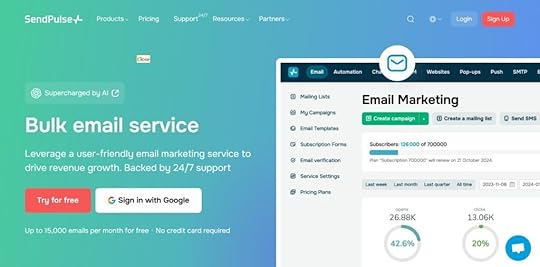
Its drag-and-drop email editor supports A/B testing and segmentation, and its visual “Automation 360” builder lets you create multi-step flows based on dozens of triggers (page visits, link clicks, purchases, etc.). SendPulse also offers AI-powered tools, including optimal send-time prediction and dynamic content. The platform is available in multiple languages and offers 24/7 support, reflecting its global focus.
In addition to its multi-channel communication tools, SendPulse also provides access to a large library of responsive email templates — all of them mobile-friendly by default. Marketers also get a built-in email verifier, ensuring that campaigns are sent only to valid addresses. The best part? Both features are available for free, making SendPulse even more cost-effective compared to competitors.
Channels: A true multi-channel marketing hub—not just email. SendPulse brings together email, SMS, Viber campaigns, web push notifications, and chatbots for Facebook Messenger, Telegram, WhatsApp, Instagram, and Viber. Everything is managed from a single dashboard, enabling businesses to reach customers wherever they are without needing to juggle multiple tools.Automation: The Automation 360 builder goes far beyond basic autoresponders. It allows complex visual workflows with multi-branch logic, triggered actions, and event-based messages. With Automation 360, it’s possible to launch emails, SMS, push notifications, and even chatbot conversations automatically, giving marketers unmatched flexibility and control.AI & Personalization: With AI-driven features like Perfect Timing, every message arrives at the moment a subscriber is most likely to open it. Personalization is advanced: use dynamic content blocks and subscriber variables to deliver campaigns that feel like one-to-one conversations at scale.Free Plan: One of the most generous free tiers in the industry—up to 500 subscribers and 15,000 emails per month, plus 3 chatbots and push campaigns for 10,000 users. Startups and small businesses receive enterprise-grade tools at no cost, while scalable paid plans unlock dedicated IP addresses, higher quotas, and advanced features.Standard Plan: $5.30/month for up to 500 subscribers. Includes unlimited email sends, responsive templates, A/B testing, and a built-in email validator for free.MailchimpMailchimp is a US‑based email marketing pioneer (founded in 2001) that has evolved into a full marketing suite. It’s known for a polished interface and ecosystem (email, landing pages, postcards, ads) and was acquired by Intuit in 2021. By 2014, Mailchimp was already sending over 10 billion emails per month for its users.
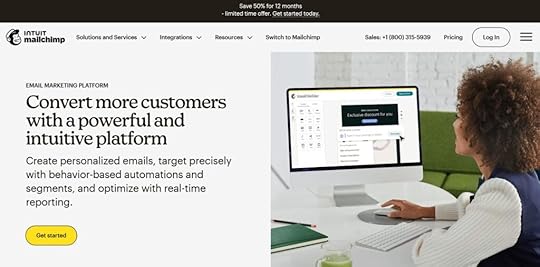
Mailchimp offers drag-and-drop email creation, A/B testing, and basic marketing automation on its free/standard plans. A key strength is its extensive integrations and marketing CRM (audiences, tags). Unlike some rivals, Mailchimp’s free plan limits you to 500 contacts and 1,000 emails/month, and many advanced automations require paid tiers.
Channels: Primarily email (templates/editor) plus some multi-channel ads; basic postcard mailing. (No built-in SMS or push notifications.)Automation: Offers multi-step email workflows on Standard/Pro plans, including welcome series, abandoned-cart follow-ups, and simple audience triggers.AI & Personalization: Generative AI email content and subject lines on higher tiers; dynamic merge tags for personalization. Advanced segmentation requires paid plans.Free Plan: Free for up to 500 contacts and 1,000 emails/month. Free users get basic email scheduling and tagging; must upgrade for advanced reports or larger lists.Essentials Plan: $13/month for 500 contacts and 5,000 monthly sends. Includes templates, A/B testing, and 24/7 email support.Brevo (Sendinblue)Brevo (formerly Sendinblue) is a French-origin platform that brands itself as an “all-in-one” marketing suite. It offers email marketing with a drag‑and‑drop editor, A/B testing and advanced segmentation, SMS marketing, and even a live chat widget on your site.
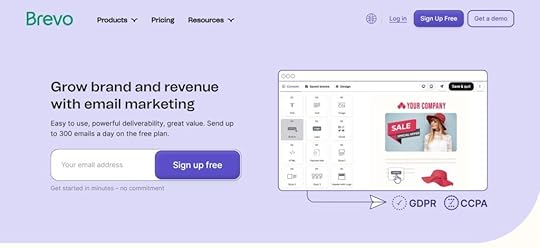
Brevo also includes a built‑in CRM, landing page builder, transactional messaging (SMTP/API), and social ad retargeting. In reviews, Brevo is praised as a robust business tool, providing chat and CRM alongside email/SMS automation. The free plan allows unlimited contacts but caps emails to 300/day.
Channels: Email, SMS, and Chat (on-site) marketing altogether; also, landing pages and CRM database.Automation: Multi-step workflows (Marketing Automation) trigger on list actions, purchases, birthdays, page visits, etc. Supports transactional and cart flows.AI & Personalization: AI-powered A/B testing and send-time optimization; conditional content in emails.Free Plan: A free tier with unlimited contacts, but limited to 300 emails/day (~9,000 emails/month). Includes basic email & SMS campaigns, and workflows.Starter Plan: $9/month for 5,000 emails per month. Removes branding, unlocks basic reporting, and provides 24/7 email support.MailerLiteMailerLite is a Latvian email tool known for simplicity and value. It has over 1M users (bloggers, small businesses).
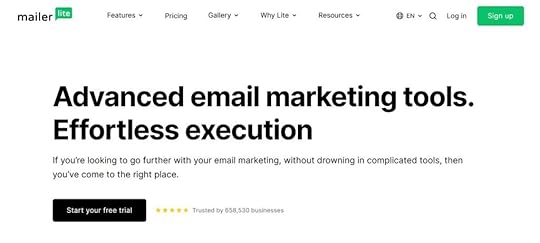
MailerLite’s strengths include a very easy drag-and-drop email and website builder, as well as automation and forms. It includes landing pages, pop-up forms, and even simple websites in the free tier. Unique features include built‑in photo editing and a content manager. However, it has fewer native channels – no SMS or push – focusing on core email and basic marketing.
Channels: Email marketing (drag‑drop editor + templates), websites/landing pages, pop-ups. No native SMS or push support.Automation: Has an intuitive workflow editor for welcome series, tagging triggers, and basic e-commerce automations (e.g., change tags on purchase). Multi‑trigger automations on higher plans (Advanced plan adds multiple triggers).AI & Personalization: Includes conditional content blocks on paid plans; simple merge tags for personalization. (No advanced AI tools currently.)Free Plan: Free forever up to 1,000 contacts and 12,000 emails/month. Free users get automation, forms, and landing pages. No credit card needed.Growing Business Plan: $10/month for up to 500 subscribers. Includes unlimited monthly emails, templates, and automation tools.ActiveCampaignActiveCampaign (founded in 2003) is a US marketing automation leader targeting small/medium businesses. It combines email marketing with a CRM and one of the most powerful automation engines on the market. Users praise its “recipes” (prebuilt automation templates) and deep segmentation.
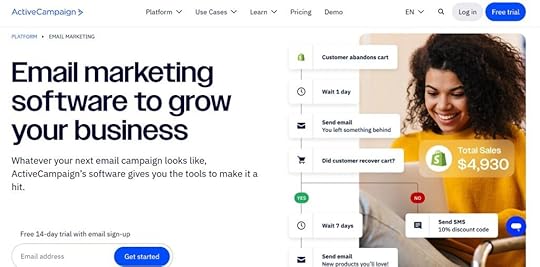
ActiveCampaign supports email, SMS (via Twilio integration), on-site messages, and even WhatsApp – all tied to its contact database. It emphasizes AI/predictive features: the platform includes AI-driven “Predictive Sending,” conditional content, and a content generator on higher tiers.
Channels: Primarily email and SMS; includes on-site notifications and WhatsApp in newer offerings. Full CRM capabilities (deal pipelines, sales automation).Automation: Extremely robust – visual workflows with 900+ triggers/actions, branching logic, goal tracking, and multi-step campaigns. “Recipes” and prebuilt templates make setup fast.AI & Personalization: AI-powered predictive sending and content (e.g., optimize delivery time, personalization strings); advanced conditional emails. Segment contacts on unlimited criteria.Free Plan: None (offers a 14-day free trial). Pricing scales by contacts and features; advanced Automations and AI come in Pro+ plans.Starter Plan: $15/month for 1,000 contacts, 10,000 emails, and automation.GetResponseGetResponse, founded in 1998, is a veteran marketer’s choice. It began as an email autoresponder and has grown into a full digital marketing suite. Today, it serves 400,000+ customers across 180+ countries.
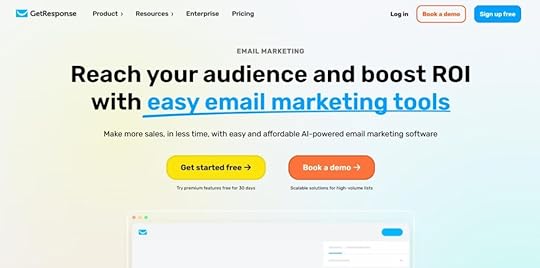
GetResponse’s standout feature is its breadth: besides email and landing pages, it offers webinar hosting, online course creation, and e-commerce integrations. It has strong automation (visual workflows, triggers like cart abandonment), and AI tools (AI email/landing-page generator, and “Perfect Timing” send-time optimization). GetResponse also supports multiple channels: you can send email, SMS campaigns, or web push notifications from one account.
Channels: Email, Web Push, SMS, live chat, and webinar tools all under one roof.Automation: Robust “Autoresponders” and workflow builder: send emails or SMS based on complex triggers (clicks, purchases, page visits), plus webinar follow-ups.AI & Personalization: Built-in AI content generation for email and landing pages; “Perfect Timing” and “Time Travel” to auto-adjust send times to each subscriber. Powerful segmentation and dynamic content support personalization.Free Plan: No free tier (free trial only). Paid plans include webinars and advanced features.Email Marketing Plan: around $19/month for up to 1,000 contacts. Includes automation, autoresponders, and funnels.OmnisendOmnisend is a specialized e-commerce marketing platform focusing on email + SMS automation. It’s built for online stores (Shopify, WooCommerce, BigCommerce, etc.) and includes product integration.

With Omnisend, you can send branded, “shoppable” emails (with product blocks) and cart-recovery campaigns. Its automation library features many prebuilt workflows for welcome series, birthdays, and abandoned carts, which merchants can easily drag and drop to customize. Omnisend also supports web push notifications. A unique selling point is generous free SMS: it even includes some SMS credits on free and paid plans.
Channels: Email & SMS are core channels; also, web push and forms. All templates support embedding product info/dynamic discount codes.Automation: Robust for e‑commerce – prebuilt workflows (welcome, cart recovery, order follow-up) plus splits and branching. Easy drag-drop automation editor.AI & Personalization: Basic segmentation by purchase behavior and engagement; dynamic discount codes. AI features are emerging (Omnisend AI offers subject-line suggestions, etc.).Free Plan: Free up to 250 contacts with 500 emails and 500 web push notifications per month (plus ~$1 SMS credit). Unlimited emails and web push notifications, but with very low SMS usage.Standard Plan: $16/month for up to 500 subscribers and 6,000 emails. Includes automation workflows, e-commerce features, and SMS add-ons.Constant ContactConstant Contact (founded in 1995) is a veteran US platform popular with small businesses and nonprofits. It emphasizes ease of use and live support. Its email editor and templates are simple but effective. Over time, it has added social media posting tools and a basic CRM, aiming to be a one-stop marketing shop.
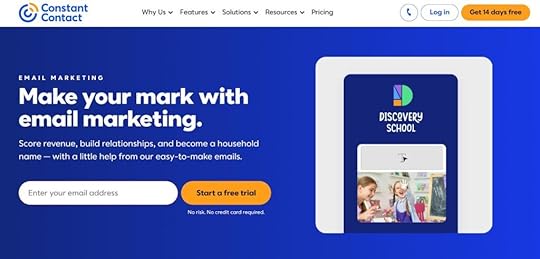
Unique interactive features include built-in email polls and RSVP surveys. Recent updates introduced multi-channel campaigns (email + social + mobile) under its “Toolkit.”
Channels: Email and basic mobile/SMS app campaigns; plus social posting (Facebook/Instagram) and events (RSVP). Has a free integrated CRM and a mobile app.Automation: Offers autoresponder series (e.g., welcome series) and simple segmenting. Dynamic content blocks allow some personalization. Advanced automation (multi-step triggers) is only available on higher Premium plans.AI & Personalization: Added an AI-powered email builder on higher tiers, featuring strong list segmentation and dynamic merge tags for customization. Good email deliverability tools.Free Plan: None (free trial only). Even the “Lite” plan starts at $12/month for up to 500 contacts.Lite Plan: $12/month. Includes core email marketing tools, templates, and basic list growth features.HubSpotHubSpot’s Email Marketing tool is part of the HubSpot CRM/Marketing Hub. It leverages HubSpot’s powerful free CRM to personalize emails. Over 248,000 customers in 135 countries use HubSpot Marketing (as of 2025).
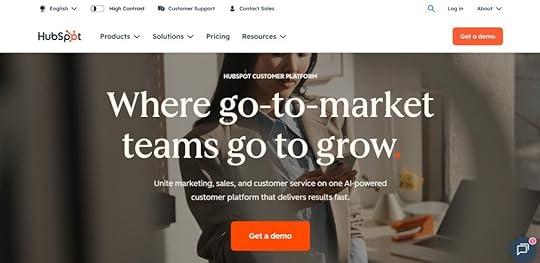
The email tool itself is modern: drag-and-drop with dozens of templates, plus AI to write subject lines and body copy. Emails can auto-personalize with CRM data (name, company, lifecycle stage) and trigger follow-ups (e.g., drip workflows based on opens or clicks). HubSpot also natively ties into ads, social scheduling, chatflows, and meetings – all under one platform.
Channels: Email campaigns and newsletters, plus chat, ads, and organic social (as part of HubSpot’s suite). Deep CRM integration means data flows freely.Automation: Basic email workflows (e.g., follow-up emails) are included even in the free tier. More complex automation (branching, multi-step funnels) is available in paid Marketing Hub plans.AI & Personalization: HubSpot offers AI-generated subject lines and email copy, as well as built-in A/B testing. You can personalize extensively using CRM fields and conditional logic on premium plans.Free Plan: The HubSpot CRM (free) includes email marketing features with up to 2,000 sends/month. No free limit on contacts. Paid plans add advanced features.Starter Plan: $17.50/month for 1,000 contacts. Provides professional email campaigns fully integrated with HubSpot CRM.KlaviyoKlaviyo is a leading email+SMS platform for consumer brands (founded 2012). It positions itself as the “CRM for consumer brands,” focusing on data-driven personalization. Klaviyo seamlessly integrates with ecommerce platforms (Shopify, Magento, etc.), pulling in purchase data to automate tailored messages. It excels at dynamic segmentation and flows (e.g., browse abandonment, personalized product recommendations).
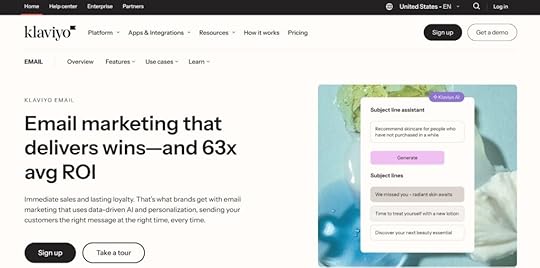
Klaviyo also introduced advanced AI tools: AI subject lines, predictive sending, and built-in deliverability optimization. The free tier is generous for try-out: up to 250 contacts with 500 email sends and 150 SMS credits. It includes all core features (email editor, flows, segments) so you can get started risk-free.
Channels: Primarily email and SMS (two-way texting). (Newer channels like push and WhatsApp are in private beta.) Integrates tightly with ecommerce data and supports in-email product feeds.Automation: Extensive event-based flows (e.g., welcome series, post-purchase, win-back). Very granular segmentation (profiles can have endless custom properties). Prebuilt templates are available for common e-commerce flows.AI & Personalization: AI-powered content generation and scheduling. Embedded CDP: Klaviyo unifies customer data to predict churn, LTV, and send the right message at the right time.Free Plan: Free for up to 250 contacts (500 emails/month) and 150 SMS credits. After that, pricing scales steeply by contact count.Email Marketing Plan: $45/month for 1,000 contacts.To Sum it UpWhen comparing the best email marketing software in 2025, SendPulse consistently rises above the competition. It goes beyond being just an email tool by offering a true omnichannel marketing platform that integrates email, SMS, web push, chatbots, landing pages, and CRM into one seamless ecosystem. This all-in-one approach enables businesses to streamline communication, reduce costs, and foster stronger connections with their audiences.
What makes SendPulse especially powerful is its combination of ease of use and advanced automation tools. The intuitive drag-and-drop editor, paired with AI-powered features, allows marketers to craft compelling campaigns, generate optimized content, and deliver messages at the perfect time for maximum engagement. The Automation 360 builder makes multi-step customer journeys simple to design, even for beginners. With one of the most generous free plans on the market, SendPulse offers unbeatable value for small businesses and growing brands.
In short, if you are looking for a scalable, AI-driven, and budget-friendly email marketing platform, SendPulse is the clear winner. It is not only the best choice for startups and SMBs but also a future-proof solution for any company ready to embrace smarter, omnichannel communication in 2025. While you’re still here, and if you’re ready to take your marketing past email, explore these top WhatsApp marketing tools that make customer support easier and campaign automation seamless.
The post 10 Best Email Marketing Tools in 2025: SendPulse vs. Competitors appeared first on Entrepreneurship Life.



